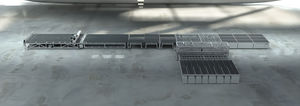
Jaw crushing plant ARS-TBXmobile
Add to favorites
Compare this product
Characteristics
- Technology
- jaw
- Mobility
- mobile
Description
The LiSEC float glass breakout system automatically breaks the trim cut at the front, the remnants at the trailing edge, as well as the X sub-plates continuously, quickly and with consistently high breaking edge quality. Thanks to the optionally available electric design of the breaker heads, individual process parameters are possible for each glass type and thickness to deliver even better breakage results for optimum precision and grind additions! Any Y and Z breakages, as well as W breakages and shapes are broken out on a downstream manual breakout table.
HOW IS THE LINE LAID OUT FOR THE AUTOMATIC BREAK-OUT OF X SUB-PLATES?
ARS: X-trim cut front and rear
TBX: Break-out of X-cuts
System operator: Breaks out the Y and Z cuts, as well as W cuts, shapes, edge and residual fractures
HOW DOES FLOAT GLASS PROCESSING TAKE PLACE?
LiSEC breakout systems for the automatic break-out of edge, remnant and sub-plate cuts, have a patented three-point breakout system. The breaker heads of this three-point technology only touch the glass on the uncoated underside and in the edge area where the Low-E or solar control coating has previously been removed (edge deletion process). This ensures that there is no contact with the surface, which minimises the risk of scratches during the manufacturing process and guarantees top quality.
HOW ARE SHAPES BROKEN OUT?
Shapes are broken out at the end of the system, after automatic edge, remnants and X-Y breakage of the sub-plate on a manual breakout table with the aid of integrated breaker bars.
Catalogs
No catalogs are available for this product.
See all of LiSEC‘s catalogs*Prices are pre-tax. They exclude delivery charges and customs duties and do not include additional charges for installation or activation options. Prices are indicative only and may vary by country, with changes to the cost of raw materials and exchange rates.






